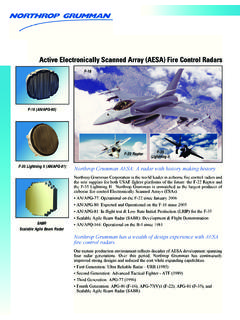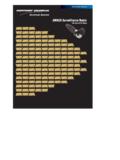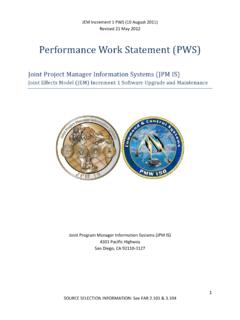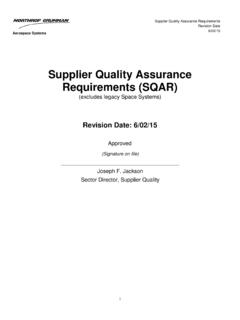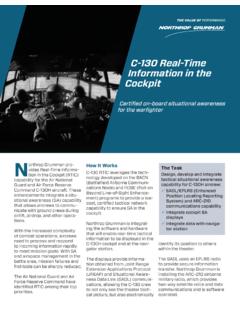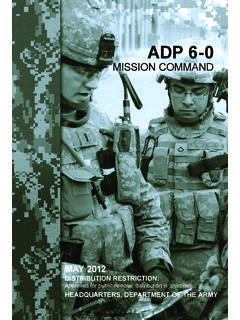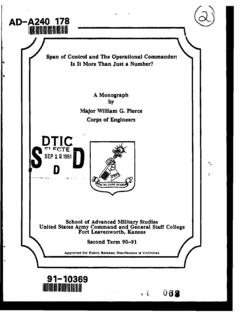Transcription of Gain maximum tactical flexibility for mission …
1 The United States Army has turned to northrop grumman to develop a warfighter-centric mission com-mand capability that will integrate current and future air and missile defense weapons and systems. With the Integrated Air and Mis-sile Defense (IAMD) Battle Com-mand System (IBCS) being devel-oped, warfighters will be able to use any sensor and any weapon to achieve mission objectives in a true open architecture environ-ment; increasing battlespace and providing dramatically improved protection for our nation and our warfighters. The IBCS will provide a fully integrated environment where soldiers trained in surveil-lance, identification, weapon management and engagements can collaboratively plan and execute engagements of hostile targets while operating under joint oversight and the rules of engagement.
2 Involves IBCS PartnershipNorthrop grumman develops the IBCS in conjunction with the Army s IAMD Project Office, Program Executive Office for Missiles and Space in Huntsville, Alabama and the Fires Center of Excellence at Fort Sill, Okla-homa. northrop grumman has pioneered the development of integrated battle command solutions and interoperable defense systems. We provide industry-leading expertise in system of systems integration, mission command, battle man-agement, communications, fire control and IAMD systems. IBCS is a major evolution in a soft-ware and hardware development process that continues to affirm northrop grumman s leadership in providing net-centric solutions designed for the way warfighters Any Sensor, Best Shooter, Any TimeComplex regular, symmetric and asymmetric air and missile threats can come from any direc-tion.
3 IBCS gives commanders the technology, tools and situational understanding to: Use composite track data from multiple sensors to gain a single, integrated air picture Acquire, assign, engage and kill incoming threats systems Select the best available weapon for the threat Create task forces and teams that are flexible, scalable and adaptable to rapidly changing situations and environments Fight the way they want to fight not the way the equipment forces them to and MissileDefense BattleCommand System(IBCS)Gain maximum tactical flexibilityfor mission success against amultitude of air and missile 2016 northrop grumman rights reserved. Approved for Public Release: ePROCS 16-1886 Common mission CommandThe IBCS is the programmed so-lution to enable common mission command across ADA and US Army forces.
4 IBCS provides the battlefield integration of Army ADA forces and their weapon systems and the supported forc-es external to IAMD. The IBCS will consist of hardware and software to integrate ADA launchers and sensors via common data and language usable by IBCS mission command solutions and share-able with networked Army ADA units and joint IAMD command and control elements. IBCS will serve as the cornerstone for mission Command in all AMD platoon, batteries, battalions, brigades and the Army Air and Missile Defense Commands (AAMDCs). Additionally, IBCS will be fielded to each Brigade Com-bat Team, each Division and each Army Corps to serve as the Air Defense Airspace Management element throughout the Army.
5 IBCS brings common mission command from the tactical level to the strategic level of New Decision ToolsIBCS will introduce new tools for the commander s tool kit; tools that assist in all aspects of air defense operations. These tools support risk-based decision-making in a high-tempo opera-Based on a non-proprietary, modular, open architecture ap-proach, IBCS establishes a net-centric system of systems that integrates sensors, weapons and battle management command, control, communications and in-telligence systems. Acting as an integrated whole, IBCS extends the effective range of individual sensors and weapons and makes them available to warfighters, thus significantly increasing the defended area and defense effectiveness in fast-paced, dynamic threat environments.
6 In other words, IBCS allows for any sensor, best shooter operations to optimize limited resources and facilitate flexible defense Flight Tests IBCS has conducted three suc-cessful flight tests within 12 months at White Sands Missile Range, NM; intercepting and de-stroying both ballistic and cruise missiles. For the first time in his-tory, the ability to identify, track, engage and defeat targets using sensors and an interceptor from different air defense systems, operating on the integrated fire control network and under the control of the IBCS, was success-fully demonstrated. Specifically a Patriot Advanced Capability Three (PAC-3) Interceptor was launched and destroyed a MQM-107 drone target, serving as a cruise missile surrogate, that only the Sentinel radar could see.
7 Because the low altitude trajec-tory of the target obscured it from the Patriot radar s field of view, the IBCS correctly used the Sentinel composite tracking data to calculate and present the nec-essary engagement solution. The engagement operations center operator then commanded, via the IBCS mission control soft-ware, the launch of a single PAC-3 interceptor missile to destroy the environment. Multiple sen-sors and situational awareness systems feed information to IBCS, enhancing a commander s decision confidence. The new tools for the commander and his staff include: Staff Planner Integrated Defense Designer Fire Control Network Manager Composite Track ManagerThese new tools provide collab-orative and distributed mission planning capabilities and in-creased, more accurate engage-ment data that allows the com-mander to make better, faster decisions.
8 For more information, please contact:For more information, please contact:Jimmy Jenkins 256-830-3465 grumman mission Systems Missile Defense and Protective Systems
